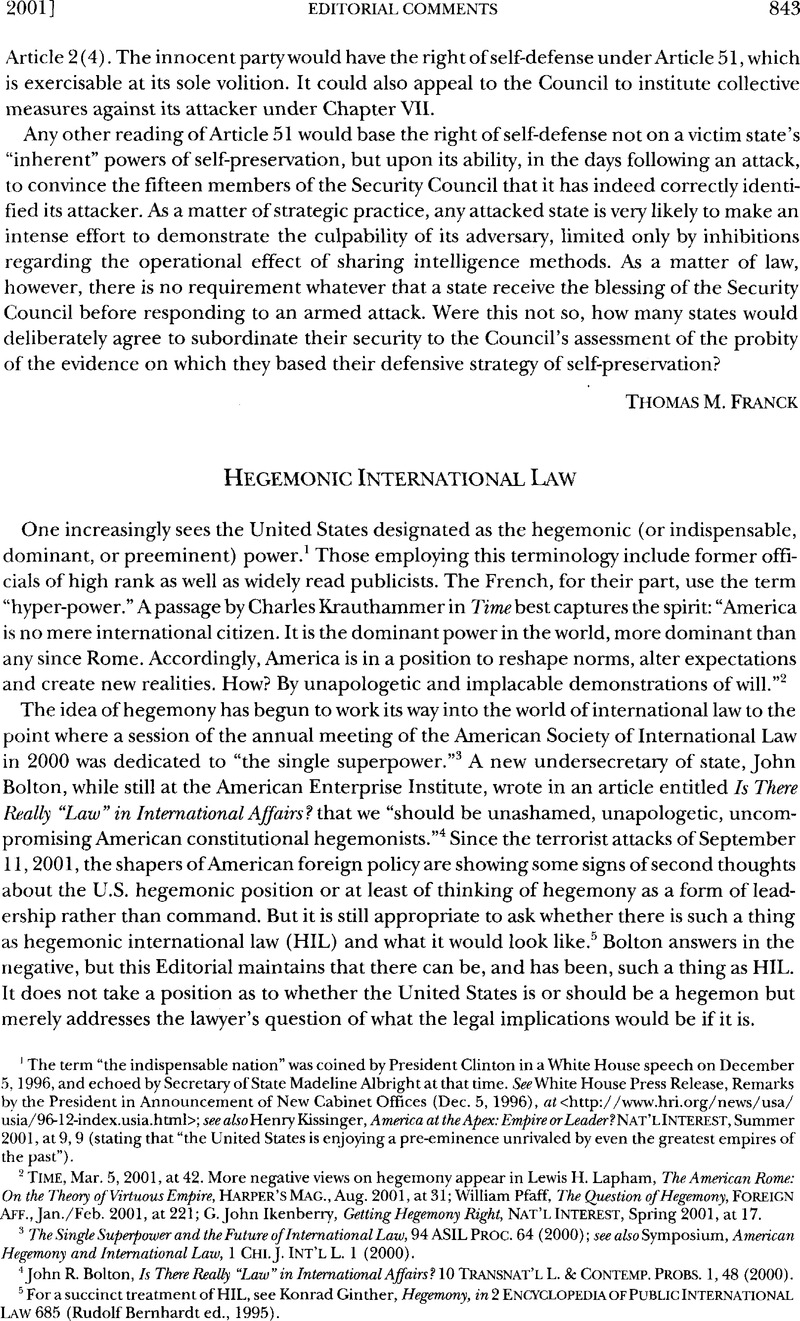Article contents
Hegemonic International Law
Published online by Cambridge University Press: 27 February 2017
Abstract

- Type
- Editorial Comments
- Information
- Copyright
- Copyright © American Society of International Law 2001
References
1 The term “the indispensable nation” was coined by President Clinton in a White House speech on December 5, 1996, and echoed by Secretary of State Madeline Albright at that time. See White House Press Release, Remarks by the President in Announcement of New Cabinet Offices (Dec. 5, 1996), at <http://www.hri.org/news/usa/usia/96-12-index.usia.html>; see also Henry, Kissinger, America at the Apex: Empire or Leader? Nat’l Interest, Summer 2001, at 9, 9 Google Scholar (stating that “the United States is enjoying a pre-eminence unrivaled by even the greatest empires of the past”).
2 Time, Mar. 5, 2001, at 42. More negative views on hegemony appear in Lewis, H. Lapham, The American Rome: On the Theory of Virtuous Empire, Harper’s Mag., Aug. 2001, at 31 Google Scholar; William, Pfaff, The Question of Hegemony, Foreign Aff., Jan./Feb. 2001, at 221 Google Scholar; John Ikenberry, G., Getting Hegemony Right, Nat’l Interest, Spring 2001, at 17 Google Scholar.
3 The Single Superpower and the Future of International Law, 94 ASIL Proc 64 (2000); see also Symposium, American Hegemony and International Law, 1 Chi. J. Int’l L. 1 (2000).
4 John, R. Bolton, Is There Really “Law” in International Affairs? 10 Transnat’l L. & Contemp. Probs. 1, 48 (2000)Google Scholar.
5 For a succinct treatment of HIL, see Konrad, Ginther, Hegemony, in 2 Encyclopedia of Public International Law 685 (Rudolf, Bernhardt ed., 1995)Google Scholar.
6 The most convenient source for those who do not read German is William, E. Scheuerman, Carl Schmitt: The End of Law (1999)Google Scholar.
7 Wilhelm, G. Grewe, The Epochs of International Law (Michael Byers trans. & rev., 2000)Google Scholar.
8 Heinrich, Triepel, Hegemonie, Ein Buch Von Führenden Staaten §22 (1938)Google Scholar.
9 Id. §16.
10 Grewe, supra note 7, at 279.
11 Alfred, Vagts & Detlev, F. Vagts, The Balance of Power in International Law: A History of an Idea, 73 AJIL. 555, (1979)Google Scholar.
12 For some observers, the permanent members of the Security Council constitute a collective hegemony within the United Nations.
13 GA Res. 34/103 (Dec. 14, 1979). The probable reason for the U.S. opposition to the resolution was its condemnation of Zionism.
14 For a critical review, see José, E. Alvarez, Do Liberal States Behave Better? A Critique of Slaughter’s Liberal Theory, 12 Eur. J. Int’l L. 183 (2001)Google Scholar.
15 Scheuerman, supra note 6, at 148–50.
16 For example, see the treatment of the balance of power and of hegemony (suzerainty) in 1 Lassa, Oppenheim, International Law: A Treatise 75, 134, 185, 292 (1905)Google Scholar.
17 Hans, Morgenthau, Politics Among Nations: The Struggle for Power and Peace (6th ed. 1985)Google Scholar.
18 He speaks of the “hidden agenda” of international lawyers, “making the unilateral use of United States force harder by raising the political and military risks and costs and thus making it less attractive to senior decisions [sic] makers.” Bolton, supra note 4, at 37.
19 Treaty of Relations, May 22, 1903, Cuba-U.S., 33 Stat. 2248, 6 Bevans 1116.
20 Scheuerman, supra note 6, at 148–50. Schmitt’s position is stated in Völkerrechtliche Formen des modernen Imperialismus (1932), reprinted in Carl, Schmitt, Positionen und Begriffe im Kampf mit Weimar—Genf— Versailles 162, 170 (1988)Google Scholar.
21 Josef, Joffe, Who’s Afraid of Mr. Big? Nat’l Interest, Summer 2001, at 43, 48 Google Scholar.
22 Detlev, F. Vagts, International Law in the Third Reich, 84 AJIL 661, 692–93 (1990)Google Scholar.
23 Vienna Convention on the Law of Treaties, opened for signature May 23, 1969, Art.52, 1155 UNTS 331.
24 See Restatement (Third) of the Foreign Relations Law of the United States §331 reporters’ note 2 (1987).
25 For similar views by Sen. Jesse Helms, see Sean, D. Murphy, Contemporary Practice of the United States, 94 AJIL 348, 352 (2000)Google Scholar ( quoting statement of Senator Helms, Jan. 20, 2000).
26 130 U.S. 581 (1889).
27 See, e.g., Louis, Henkin, The Constitution and United States Sovereignty: A Century o/Chinese Exclusion and Its Progeny, 100 Harv. L. Rev. 853 (1987)Google Scholar.
28 Louis, Henkin, Foreign Affairs and the Constitution 305 (2d ed. 1996)Google Scholar.
29 Detlev, F. Vagts, The United States and Its Treaties: Observance and Breach, 95 AJIL 313,. 318, (2001)Google Scholar.
30 Frederick of Prussia, The Refutation of Machiavelli’s Prince or Anti–Machiavel, ch. 6 (Paul Sonnino trans., Ohio Univ. Press 1985). Frederick wrote the book in French in 1740.
31 Jonathan, I. Charney, The Persistent Objector Rule and the Development of Customary International Law, 1985 Brit. Y.B. Int’l L. 1 Google Scholar. Relations between power and customary law are explored in Michael Byers, Custom, Power and the Power of Rules (1999).
32 175 U.S. 677, 719 (1900) (Fuller, C.J., dissenting).
33 Paul, B. Stephan, Creative Destruction—Idiosyncratic Claims of International Law and the Helms–Burton Legislation, 27 Stetson L. Rev.. 1341, (1998)Google Scholar.
34 Bolton, supra note 4, at 6 (citation omitted).
35 504 U.S. 655 (1992).
36 Rudyard, Kipling, “Recessional” (1897)Google Scholar.
- 41
- Cited by


